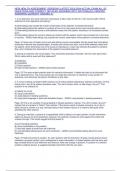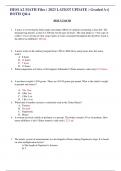-
1. Examen - Nursing 270 : hesi exit comprehensive exam - latest complete solutions, a ; concorde ...
-
2. Examen - Hesi exit v2 2021.docx
-
3. Examen - Hesi a2 health education systems inc tb.pdf
-
4. Examen - Hesi rn fundamentals exam 3 versions combined
-
5. Examen - Hesi comprehensive exam 2020
-
6. Examen - 2022 hesi med-surg rn custom exam (for med surg ii class) pics & q&as included (a+)
-
7. Examen - hesi exit rn exam over 700 questions, answers rationale new2020-2021 ,a graded docum...
-
8. Examen - 2022 - 2023 hesi pediatric (peds) exit exam version 1 and 2 (v1 & v2) - all q&as (bra...
-
9. Examen - 2022 - 2023 hesi ob maternity version 1 (v1) exit exam (all 55 qs) tb w-pics included...
-
10. Examen - Hesi fundamentals 2022-2023 exams graded a+.
-
11. Examen - Pharmacology hesi practice exam hesi pharmacology exam questions and answers with r...
-
12. Examen - Hesi exit exam 750 questions & answers hesi exit rn exam hesi rn exit exam (newest,...
-
13. Examen - 2020/2021 hesi health assessment nursing rn v1 100 questions with answers 1. during a...
-
14. Examen - Hesi med surg med surg 55 questions rn v1 (most answer(s)) latest
-
15. Examen - 2020 advanced pathophysiology hesi rn questions and answers
-
16. Examen - Hesi medsurg 2023 exam - latest updated study guide
-
17. Examen - Exit hesi test bank (over 1000 q's and answers ) spring 2023 exit hesi prep distinct...
-
18. Examen - Hesi rn exit exam v1-v7 (latest 2023-2024) rn exit hesi exam v1,v2,v3,v4,v5,v6,v7 lat...
-
19. Examen - Hesi pharmacology actual exam questions 2022 (55 q&a). hesi pharmacology actual exam ...
-
20. Examen - Hesi fundamentals exit exam version 1 (v1) (2022-2023) (all 300 q&a) (100% verified q...
-
21. Examen - 2022/2023 hesi pharmacology question bank 100% verified questions with rationale 1) a...
-
22. Examen - All hesi exit questions and answers test bank; a+ rated guide (2022) latest update
-
23. Examen - Hesi pharmacology actual exam questions 2022 (55 q&a)
-
24. Examen - Hesi fundamentals exit exam version 1 (v1) (2022-2023) (all 55 q&a) (100% verified q&...
-
25. Examen - Hesi exit exam 2023-2024 test bank latest updade
-
26. Examen - Hesi a2 grammar, vocab, reading, & maths version 2 latest 2023
-
27. Examen - Hesi a2 maths with solved answers v1 only latest 2023
-
28. Examen - Hesi a2 critical thinking exam with answers latest 2023
-
29. Examen - Hesi a2 grammar, vocab, reading, & maths version 2 graded a+
-
30. Examen - Hesi med surg med surg 55 questions rn v1 (most answer(s)) latest 2023
-
31. Examen - Hesi med surg med surg 55 questions rn v1 (most answer(s)) latest 2023
-
32. Examen - Hesi lpn comprehensive exit exam latest 2023 questions & answers with rationale.
-
33. Examen - 2023 hesi exit v3 latest upgraded.
-
34. Examen - 2023 hesi pharmacology question bank 100% verified questions with rationale latest
-
35. Examen - Hesi mental health rn random from all v1-v3 2023 test banks (all together- various te...
-
36. Examen - 2023 hesi pharmacology (pharm) exam version 1 (v1) brand new q&as guaranteed pass a+ ...
-
37. Examen - Hesi exit rn exam-756 qa, hesi exit rn exam (version 1 to version 7) hesi exit rn exa...
-
38. Examen - Hesi fundamentals latest june 2023
-
39. Examen - Ati pn hesi fundamentals proctored exam (21 latest versions, 2023) pn ati fundamental...
-
40. Examen - Hesi lpn-adn entrance exam (mobility exams) a+ graded 100% verified
-
41. Examen - Solved] hesi critical care test bank rn 2022-2023
-
42. Examen - (complete 275 q&a) med-surg ii hesi test bank 2022-2023
-
43. Examen - Hesi pn exit exam v3 110 latest 2023 questions and answer(s)
-
44. Examen - 2023 hesi rn -evolve obstetrics- maternity practice exam latest updated
-
45. Examen - Hesi mental health rn questions and answers from v1-v3 test banks and actual exams (l...
-
46. Examen - Hesi pharmacology actual exam questions 2023 (55 q&a)
-
47. Examen - Hesi fundamentals practice test evolve practice test ( 2021 latest update ) q&a hesi ...
-
48. Examen - Hesi a2 math files ( 2023 latest update ) graded a+ both q&a
-
49. Examen - Hesi a2 entrance exam latest version ( 2023 update )
-
50. Examen - Hesi medical surgical 1 version 1 55 questions and answers
-
51. Examen - Hesi critical care 2023 100%, graded a+ test bank rn
-
52. Examen - Hesi medical surgical 1 version1 55 questions and answers 100 % latest 2023
-
53. Examen - Hesi medical surgical 1 version1 55 questions and answers 100 % latest september 2023
-
54. Examen - Hesi testbank latest updated 2023 1) a nurse is caring for a client with hyperparath...
-
55. Examen - Hesi rn pharmacology 2022 v2 exam & study guide 1. a home care nurse is instructin...
-
56. Examen - 2023_hesi_exit_rn_exam_v1.v2_v3_v4_v5_v6_v7_latest_volumes
-
57. Examen - Hesi rn fundamentals exam | 3 versions combined
-
58. Examen - Hesi rn fundamentals v1 and v2 latest updated 2023 100% complete graded a+
-
59. Examen - . pn hesi exit exam 2023 version 1, 2, 3 test bank question with answers latest updat...
-
60. Examen - Hesi health assessment latest 2023 test bank real exam 200+questions and detailed ans...
-
61. Examen - Med-surg ii hesi test bank 2023, all answers verified {100% correct} hesi med-surg te...
-
62. Examen - Hesi pharmacology actual exam questions 2023 (55 q&a) latest graded a+
-
63. Examen - hesi pharmacology question bank 100% verified questions with rationale 2023-2024
-
64. Examen - 2023 critical care hesi exit version 2 (v2) test bank guide - next gen format - a all...
-
65. Examen - All hesi exit questions and answers test bank; a+ rated guide (2023) already graded a...
-
66. Examen - Hesi milestone 2 actual exam 3 latest versions (v1, v2 and v3) 2023-2024 each version...
-
67. Examen - Hesi pharmacology question bank 100% verified questions with rationale 2023|already g...
-
68. Examen - Rn hesi exit exam 2023 version 1(v1)-all 160 questions and answers|graded a+
-
69. Examen - Rn hesi exit exam 2023 version 1(v1)-all 160 questions and answers|graded a+
-
70. Examen - 2023 pediatric (peds) hesi exit version 1 (v1) test bank: next-gen format (all 55 que...
-
71. Examen - Hesi pediatric exam 55 questions download to score a (2023/2024)|already graded a+
-
72. Examen - Hesi a2 version 3 complete exam 2023-2024 grammar, math, reading, biology, vocabulary...
-
73. Examen - Exit hesi practice questions and answers test bank a+ rated guide (2024)
-
74. Examen - Hesi rn exit exam questions and answers test bank a+ rated guide (2024)
-
75. Examen - Hesi rn exit exam questions and answers test bank a+ rated guide (2024)
-
76. Examen - Hesi a2 a&p v2 100% complete|already graded a+
-
77. Examen - Hesi a2 (anatomy & physiology) v1/v2 100% complete| already graded a
-
78. Examen - Hesi math, a&p, reading, vocabulary, grammar|already graded a+
-
79. Examen - Hesi math, a&p, reading, vocabulary, grammar|already graded a+
-
80. Examen - hesi a2 – gramma, hesi math, a&p, reading, vocabulary, grammar|already graded a+
-
81. Examen - Hesi peds milestone 2 remediation 2023-2024 actual exam contains 200 questions and co...
-
82. Examen - Hesi milestone 2 remediation 2023-2024 actual exam contains 200 questions and correc...
-
83. Examen - Hesi exit rn exam (15 exam sets, 2500 q & a, newest-2024) hesi rn
-
84. Examen - Study exit hesi v1 2014.docx
-
85. Examen - Hesi fundamentals exam test bank 2024 | accurate real exam questions and answer | ver...
-
86. Examen - Hesi health assessment version 5 latest actual exam all 55 questions and correct deta...
-
87. Examen - Hesi health assessment version 4 latest 2023-2024 actual exam all 55 questions and co...
-
88. Examen - Hesi health assessment version 5 latest 2023-2024 actual exam all 55 questions and co...
-
89. Examen - Hesi a2 module section iv science biology and chemistry verified
-
90. Examen - Hesi v2 health assessment questions and answers.docx
-
91. Examen - Hesi prep health assessment 124 practice questions and answers latest 2023-2024 (a+ ...
-
92. Examen - Hesi milestone #1 practice exam 23 questions and answers graded a+ 100% complete
-
93. Examen - Hesipeds developmental milestones questions and answers 2023-2024
-
94. Examen - 2020 advanced pathophysiology hesi rn questions and answers
-
95. Examen - Hesi rn pharmacology review 2024 v2 –65questions+reviewofimportantpoints
-
96. Examen - Hesi v2 health assessment questions and answers latest 2024
-
97. Examen - Hesi v2 health assessment questions and answers latest 2024
-
Mostrar más





